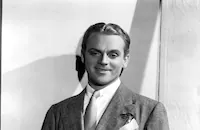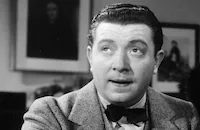The Crowd Roars

Brief Synopsis
Cast & Crew
Howard Hawks
James Cagney
Joan Blondell
Ann Dvorak
Eric Linden
Guy Kibbee
Film Details
Technical Specs

Synopsis
Racecar driver Joe Greer strongly believes that a family has no place in racing. For this reason, he refuses to marry his mistress, Lee Merrick, and tries to discourage his younger brother Eddie from taking up the sport. Once he learns that Eddie is determined to race and that he is good at it, however, Joe agrees to take him on the road, but tries to protect him from the less attractive side of racing. He keeps his relationship with Lee a secret, deeply wounding her by his actions. He completely breaks with Lee when he discovers Eddie having a drink with her and her friend, Anne Scott. Furious at the way her friend has been treated, Anne decides to seduce Eddie, but to her surprise, she falls in love with him. Joe, who is drinking heavily, and Eddie quarrel over Anne, parting bitterly. Joe's backup driver, Spud Connors, tries to separate the brothers in a race that night, and a drunken Joe drives him off the track to his death. His nerve broken by Spud's death, Joe starts losing races and ends up riding the rails as a hobo. Lee, who is still in love with Joe, borrows money to travel to Indianapolis for the 500 race, certain that Joe will be there. She meets him at the lunch stand where she is working and learns that he stopped drinking after Spud's death. During the race, when Eddie has a blowout and is injured, Joe takes over as relief driver, winning the race just before his car crashes. Joe is not badly hurt, and he and Eddie are reconciled.

Director

Howard Hawks
Cast

James Cagney

Joan Blondell

Ann Dvorak

Eric Linden

Guy Kibbee

Frank Mchugh
Billy Arnold
Leo Nomis
Fred Frame
Ralph Hepburn
Wilbur Shaw
"shorty" Cantlon
Mel Keneally
Stubby Stubblefield
Harry Hartz
Fred Guisso
Spider Matlock
Jack Brisko
Charlotte Merriam
Crew
Carl Akeley
Wesley Anderson
John Bright
Niven Busch
Elmer Dyer
Leo F. Forbstein
E. B. Gilmore
Kubec Glasmon
Harry Hartz
Howard Hawks
Sid Hickox
Fred Jackman
Robert Lee
Seton I. Miller
Jack Okey
Thomas Pratt
Ray Ramsey
John Stumar
Richard Towers
William Walling Jr.

Videos
Movie Clip



Trailer
Film Details
Technical Specs

Articles
The Crowd Roars (1932)
This is by no means a subtle movie, but it's a lot of fun, and its poster made it abundantly clear what viewers back in 1932 would be seeing when they forked over their Depression-era money: ³He's a speed mad race driver who laughs at death...she's the girlfriend who packs dynamite in her kisses and TNT in her slaps! If they don't make your heart pound with excitement, you're not human!² Cagney was on the verge of major stardom when the picture was released, and audiences ate it up. His tough-guy demeanor isn't as complex as it would get in some of his later films, but he oozes enough cocky charisma to overwhelm a barely plausible storyline.
Cagney plays Joe Greer, a hotshot racecar driver whose kid brother, Eddie (Eric Linden) idolizes him. Joe realizes his lifestyle probably isn't the best thing for a kid, although he's not particularly interested in abandoning it himself. Joe, you see, has a taste for loose women, and actually lives with one (Ann Dvorak.) Eddie takes up racing himself, and becomes an on-track rival of Joe's. Then, wouldn't you know it, Eddie shows up with a brassy broad (Joan Blondell, who made a good living playing this character) on his arm. This leads to a bout with alcohol for one of the main characters, and an unlikely turn of events at the Indy 500 that's about one step removed from Judy Garland wowing Broadway when the big star breaks her leg in the middle of a show. No one called this a documentary.
Warner Bros.' publicity department certainly wasn't shy about exploiting the accidents that occurred while The Crowd Roars was being shot. One story that was fed to America's newspapers proudly stated that ³fourteen cars were wrecked in nine major accidents and seven men were sent to the hospital.² Wow! Too bad nobody got killed!
Hawks, however, revealed in an interview many years later that the Dusenberg car company designed a tow bar for him that could be used to pull cars at speeds of up to 120 mph. Cars with rigged tires could then be released onto the track, and everyone would know exactly where the crash was about to occur. He claimed that there were actually no unwanted mishaps while making the movie. Of course, earlier in the same interview, he also describes a massive on-set pile-up, so who knows what the truth is. (Hawks' anecdote about a driver on the picture who could barrel around the track at top speeds, while blindfolded, also sounds more than a little bit suspicious.)
Indianapolis Motor Speedway, of course, serves as the location for the climactic race, but other scenes were shot at California's Ventura Speedway and Ascot Speedway. Many real-life racing champions, including Fred Frame, Leo Nomis, Ralph Hepburn, Harry Hartz, Spider Matlock, and Wilbur Shaw, took part in the races, and they also served as technical advisors. None of them was ever known to drive while blindfolded.
In his highly entertaining autobiography, Cagney by Cagney, Cagney recalls being forced to confront Warner's front office while shooting The Crowd Roars. There he was, a certain future star for one of the biggest film production companies in the land, and he was only pulling in $400 a week. Cagney knew that the biggest draws at Warner Bros. were making $125,000 a picture, so, as he put it, "that $400 soon stopped because I walked."
At the same time, Cagney also had the guts to sue Warner Bros. for placing another actor's name above his on a marquee at a movie theater in Hollywood. His contract clearly stipulated that this couldn't be done. Cagney won the lawsuit, and also ended up with a raise before he returned to complete The Crowd Roars. This wouldn't be the last time that he would stage a personal strike when he felt producers were taking advantage of him. In all of studio-era Hollywood, perhaps only Katharine Hepburn and Bette Davis showed as much backbone while dealing with the overlords.
The Crowd Roars may not be the most memorable film of Cagney's career, and he surely didn't harbor fond memories of wrestling with Warner Bros. But he came away from the production with something that he would cherish for the rest of his life: a dear friend.
After their first day of filming, Cagney and his co-star, Frank McHugh, retired to the hotel suite that they were sharing while working in Santa Barbara. The two men had met briefly a couple times before, but they started a conversation that, once they realized how much they had in common, lasted until early the next morning. They reported to work the next day without having slept a wink, and remained friends for the rest of their lives.
Director: Howard Hawks
Writers: John Bright, Niven Busch, Kubec Glasmon (based on a story by Seton I. Miller and Howard Hawks)
Photography: Sidney Hickox
Editor: Thomas Pratt
Music Director: Leo F. Forbstein
Art Direction: Jack Okey
Principal Cast: James Cagney (Joe Greer), Joan Blondell (Anne), Ann Dvorak (Lee), Eric Linden (Eddie Greer), Guy Kibbee (Dad Greer), Frank McHugh (Spud Connors), William Arnold (Bill Arnold), Leo Norris (Jim), Charlotte Merriam (Mrs. Spud Connors), Regis Toomey (Dick Wilbur), James P. Burtis (Mechanic), Sam Hayes (Announcer) .
BW-70m. Closed captioning.
by Paul Tatara

The Crowd Roars (1932)
Quotes
Trivia
Notes
The film opens with a tribute to the famous racing drivers who appear in the production, many of whom play themselves in the race scenes. William Arnold, who plays Bill in the film, was the winner of the 1930 Indianapolis 500 race. According to Film Daily, Dorothy MacKaill was considered for the part of Lee. Modern sources list the following additional cast credits: Phil Pardee, Lou Schneider, Bryan Salspaugh (Racing drivers), James Burtis (Mechanic), Sam Hayes (Ascot announcer), Robert McWade (Tom, counterman), Ralph Dunn (Official), John Conte (Announcer) and John Harron (Red, Eddie's pitman). Additional modern source crew credits include: Supervisor, Raymond Griffith; Makeup, Perc Westmore; and Assistant Director, Dick Rosson. Modern sources list The Roar of the Crowd and The Roaring Crowd as alternate titles and state that the race scenes were filmed at Indianapolis, Ventura and Ascot race tracks. A French-language version, La foule hurle, was also produced in 1932. Warner Bros. remade this film in 1939 as Indianapolis Speedway (see below).















